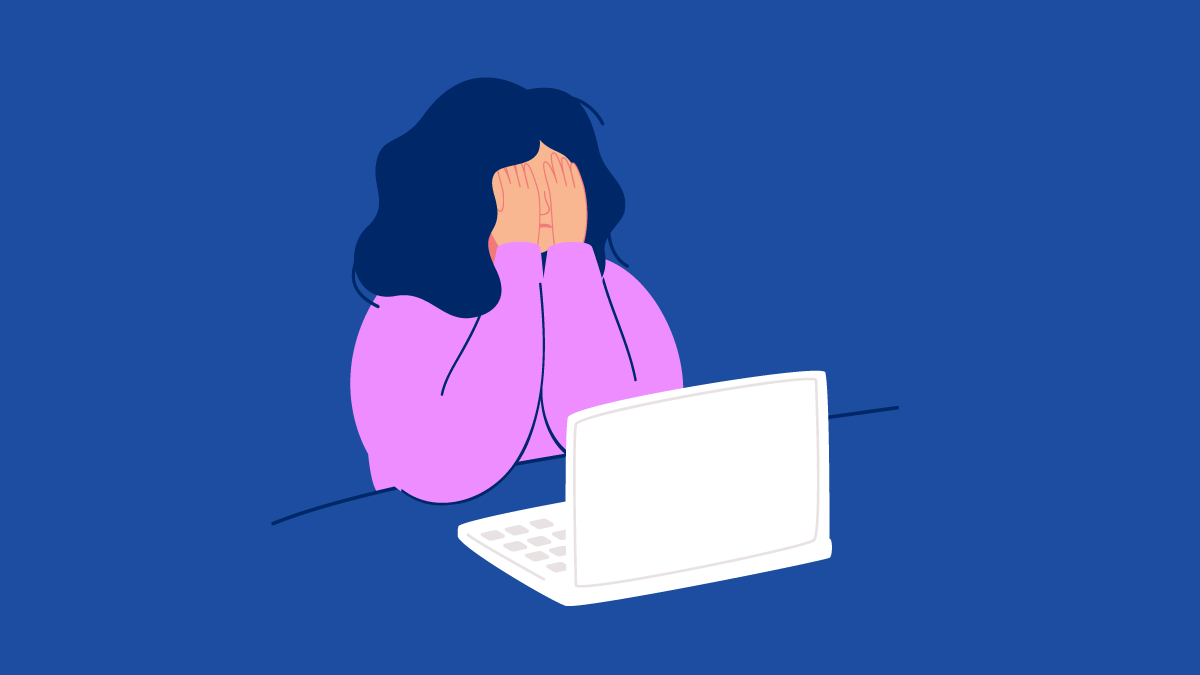Image Source: iStock/Mary Long
Modern tech is wonderful, isn’t it?
If you’re reading this blog right now, it’s because of technology. In fact, four in ten Americans say that technology has improved their lives the most. The same technology has allowed us to work remotely.
Talking about remote work, we know the perks (no commute, flexible hours, comfort of home). But with that, also comes the not-so-talked-about challenge: digital overload. Between video calls, constant pings from messaging apps, overlapping task managers, and a dozen open tabs, it’s easy to feel stretched thin and scattered. Sound familiar?
That’s why the concept of digital minimalism exists. No, it doesn’t ditch technology altogether but focuses on using it more intentionally. Instead of juggling five apps for one task, digital minimalism encourages you to focus on what actually helps you work better and drop the rest.
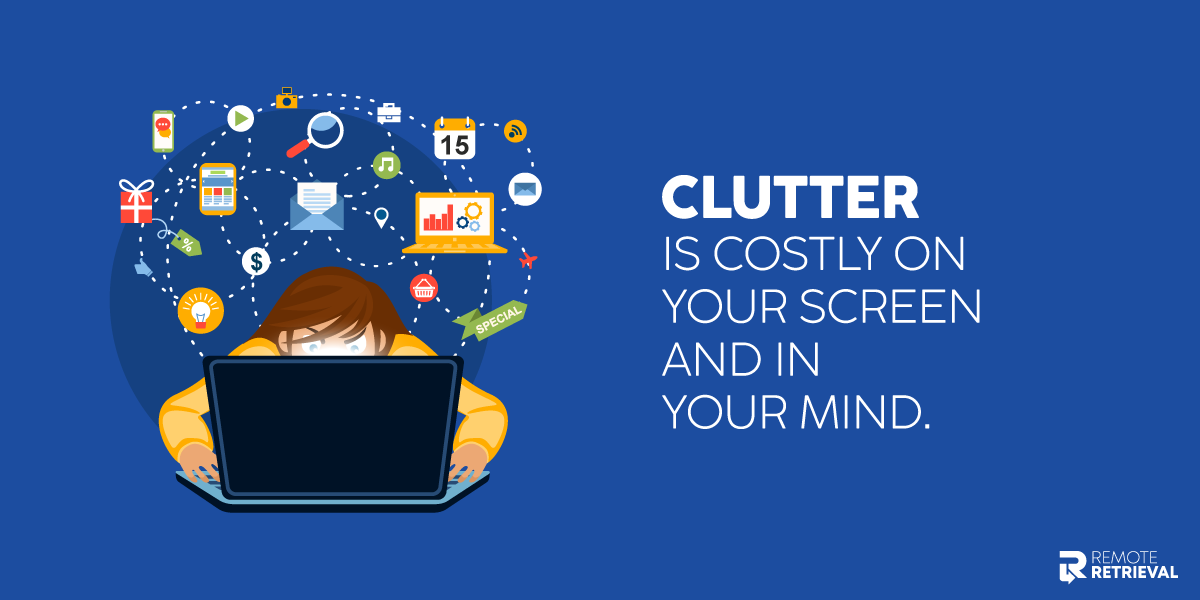
In a world where every tool claims to boost productivity, sometimes the real productivity hack is doing less, on purpose. So, let’s discuss how trimming down your digital tools and streamlining your tech setup can reduce distractions, improve focus, and make your remote workday a whole lot smoother.
What Is Digital Minimalism?
Cal Newport, a computer science professor at Georgetown University, popularized the concept of digital minimalism. In his book Digital Minimalism: Choosing a Focused Life in a Noisy World, he explains how being intentional about your tech habits can lead to better focus and less overwhelm.
At its core, digital minimalism is about using technology with purpose, keeping the tools that genuinely add value, and cutting out the rest. For remote workers, this could mean decluttering their digital space, turning off unnecessary notifications, or sticking to just one or two essential remote work tools instead of ten.
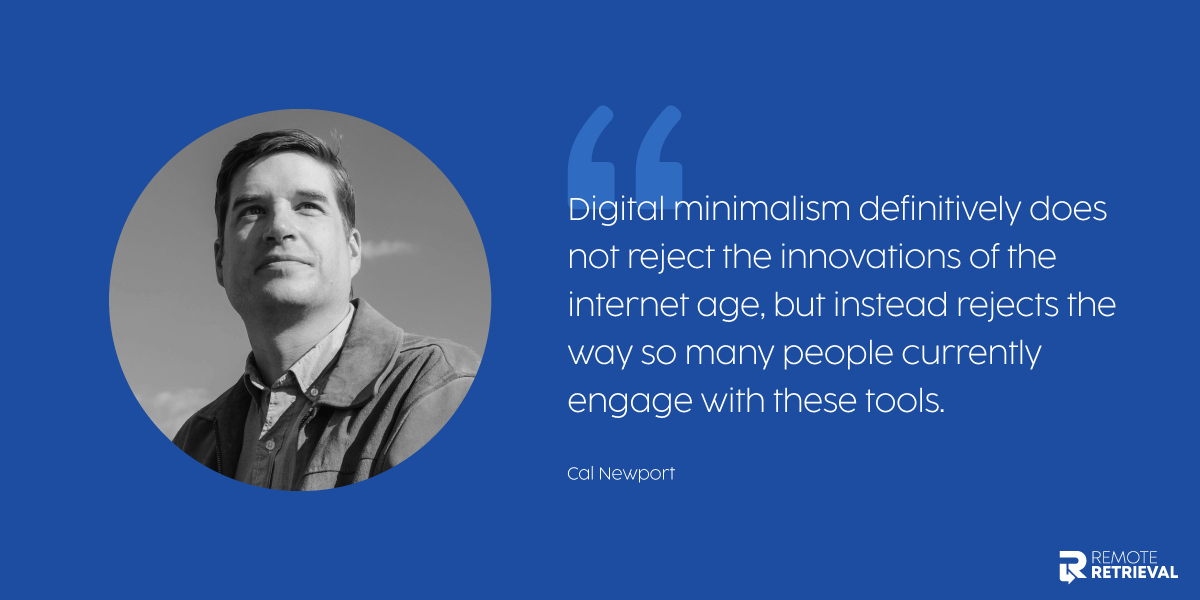
As Newport puts it, digital minimalism is a way to “clear away low-value digital noise” so you can make room for what really matters.
Signs you might need digital minimalism:
-
You switch between tabs out of habit, not need
-
You check emails or messages even when there’s no alert
-
You feel mentally drained after a day at the screen
-
You scroll through content late at night without purpose
-
You spend hours working, but feel unproductive
-
You find it hard to stop checking your phone during work
Key Challenges Remote Workers Face Due to Digital Overload
Remote work impacts the environment and brings flexibility; however, it also opens the door to constant digital interruptions. When your workspace is entirely online, it’s easy to get overwhelmed by tools, notifications, and non-stop communication.
Below are some of the most common issues remote professionals experience due to digital overload and how they impact everyday productivity and well-being.
1. Disrupted Focus and Lower Productivity
One of the biggest challenges of digital overload is the way it breaks your concentration. With constant notifications, emails, and chat messages, staying focused on one task becomes difficult. Every small interruption pulls you out of your workflow and forces your brain to readjust.
This back-and-forth is exhausting and slows down your ability to complete tasks efficiently. As a result, even a full day of work can feel unproductive, especially when you’re juggling too many tabs, tools, or communication channels at once.
2. Rising Risk of Burnout
Always being online often creates a sense of urgency to respond quickly, stay active, and never miss an update. Over time, this pressure adds up and leads to mental fatigue. You might find it hard to switch off even when the workday is done. Almost 75% of remote workers say that they have experienced burnout in some form or another.
The lack of recovery time wears down your mental resilience and emotional energy. What begins as occasional stress can gradually turn into burnout, affecting not only your performance but also your overall motivation and mood.
3. Blurred Boundaries Between Work and Life
Without the physical separation of an office, the line between work and personal time can disappear. In fact, 65% of remote workers report working more hours than they did while working in the office. That’s because remote workers often feel compelled to check emails late at night or finish tasks outside of regular hours.
It starts off as being flexible but can quickly lead to extended workdays and reduced downtime. Over time, this constant availability cuts into personal space and rest, both of which are critical for maintaining mental health and long-term productivity.
4. Overwhelmed by Excessive Information
Too many messages, updates, files, and app alerts can overwhelm even the most organized person. With so much information coming from multiple sources, it becomes difficult to decide what’s urgent and what’s not.
This may lead to decision fatigue, where making even small choices feels exhausting. You end up stuck in a loop of shallow work—responding, reacting, and reviewing—without progressing on tasks that matter.
How Digital Minimalism Transforms the Remote Work Experience
As we’ve already discussed, digital minimalism doesn’t mean eliminating technology entirely. For those working from home, it means creating a digital setup that supports focus, boundaries, and well-being, rather than adding more noise to an already busy day.
By managing remote work productivity and cutting down on digital clutter, you can work smarter and feel more in control of your time. Here’s how this approach helps.
1. Improved Focus and Productivity
Minimizing digital distractions allows you to concentrate on important tasks. When your screen isn’t cluttered with multiple apps, tabs, and alerts, you can stay in deep focus for more extended periods.
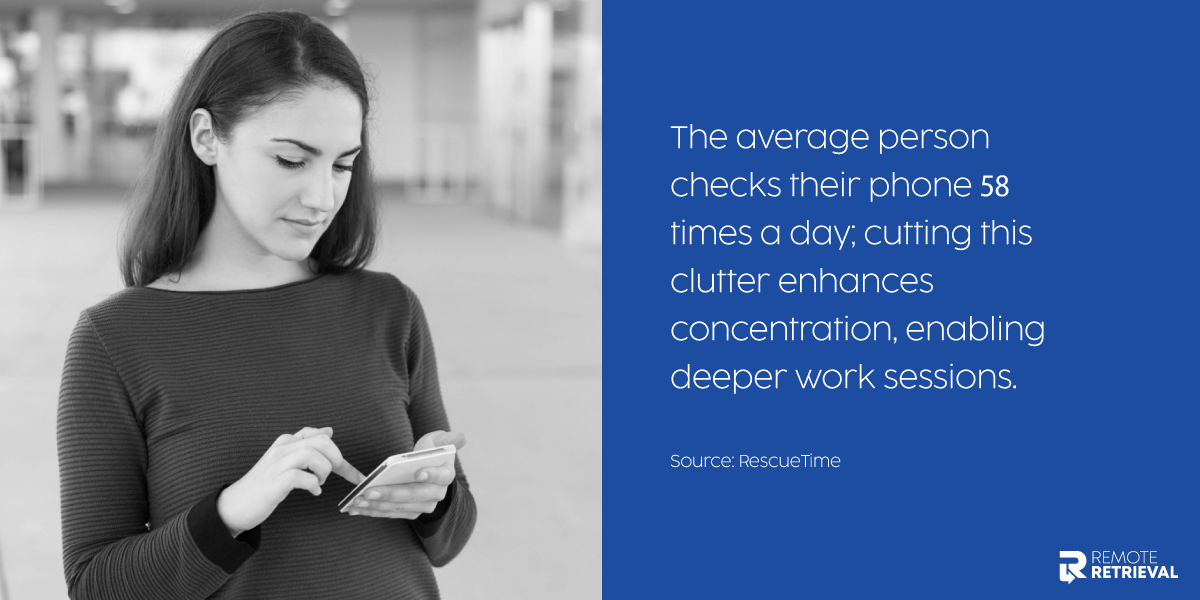
This way, you can reduce task-switching and keep your mind from constantly shifting gears. Using fewer, more focused tools also makes your workflow more efficient. For example, a distraction-free writing tool or a simple task manager can help you stay on track without overwhelming your attention span.
2. Better Boundaries Between Work and Personal Life
One of the most important benefits of digital minimalism is the ability to draw clearer lines between work and downtime. Remote work can blur these boundaries, but with intentional digital habits, you can maintain a healthier balance. Did you know, workers who check emails less frequently report lower stress and better focus?
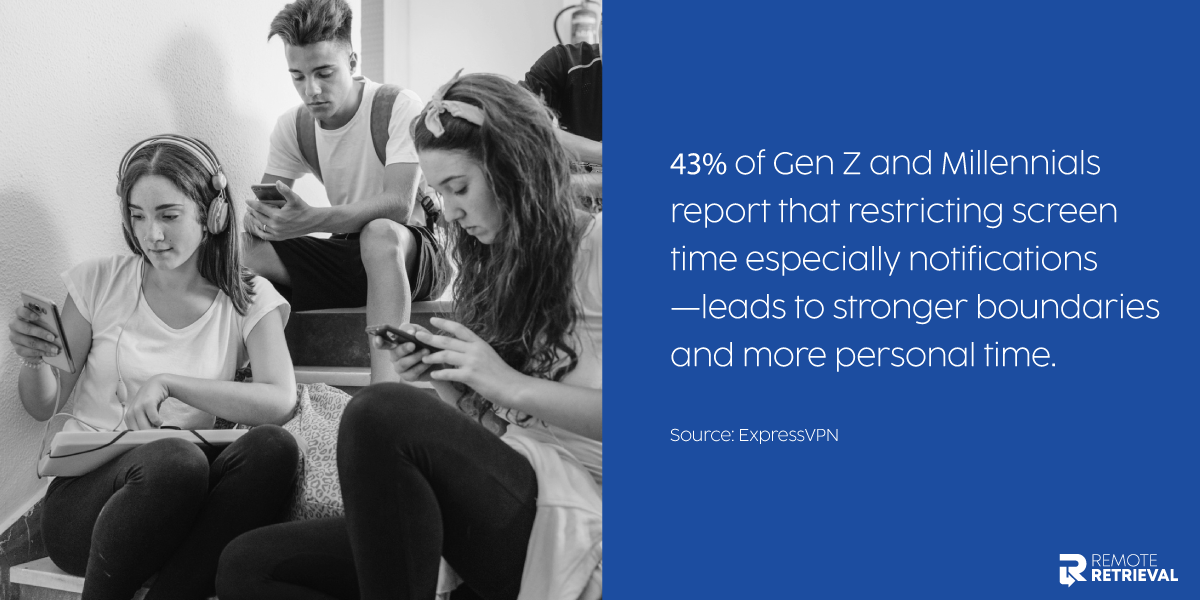
Setting fixed work hours, turning off non-essential alerts after the day ends, and having a defined workspace (even if small) are all part of this practice. These small adjustments help ensure your time after work is yours.
3. Stronger Support for Mental Well-Being
Being constantly connected can lead to stress, fatigue, and eventual burnout. Digital minimalism helps by encouraging more mindful engagement with technology. Instead of reacting to every ping, you become more selective, choosing when and how to engage.
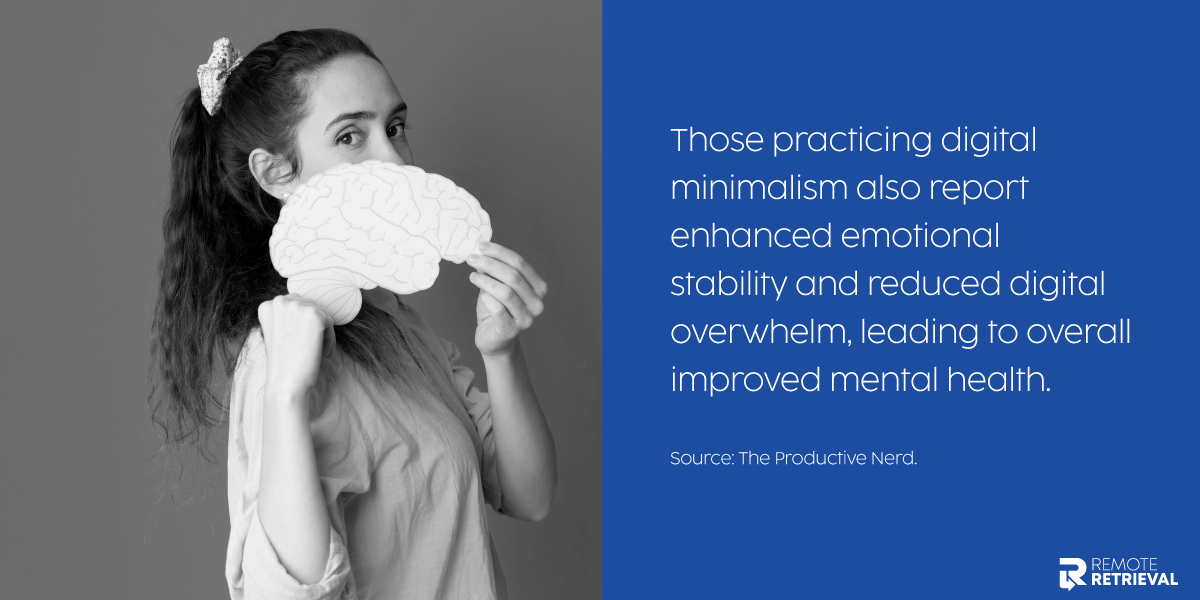
Taking breaks from screens, limiting exposure to overwhelming content, and creating quiet moments away from tech are essential habits that help reduce anxiety and improve mental clarity. This gives your brain room to rest and reset.
Steps to Build a Healthier Digital Routine
Here’s how you can start building a digital environment that supports your remote work.
1. Start with a Digital Self-Check
Take inventory of your current tech usage. Which apps, platforms, or tools are helping you get work done, and which are just taking up space or time? Whether it’s unused browser extensions, outdated apps, or devices you rarely touch, the goal is to clear out what no longer serves a purpose. If you’re holding onto company devices from a past job, now’s the time to pack, ship, and return laptops safely.
2. Declutter Your Digital Desk
Your digital workspace can get messy fast—files everywhere, tabs always open, tools overlapping. Start by cleaning up your desktop, sorting files into folders, and using cloud storage to keep things streamlined. Choose simple and easy-to-navigate tools that help you stay focused instead of being distracted by visual noise or complex features.
3. Be Clear About Why You Use Tech
Not all tech is bad; it’s how and why we use it that matters. Think about what you want your digital tools to help you achieve. Are you trying to be more productive, reduce stress, or create clearer work-life boundaries? When you know your goals, it becomes easier to say no to the distractions and yes to what actually supports your day.
4. Build a Rhythm That Supports Focus
A daily structure makes it easier to stay in control of your digital habits. Set specific times to check email, reply to messages, or scroll through updates rather than reacting to every ping throughout the day. Protect blocks of time for focused work and allow for regular breaks away from screens. You can also try listening to music to boost creativity and focus during deep work sessions. Instrumental or ambient tracks often help reduce distractions without interrupting your thought flow. This balance can reduce fatigue and sharpen your concentration.
5. Use the Right Tools—For the Right Reasons
Technology can still support minimalism, as long as it’s the right kind. Tools like time trackers, distraction blockers, or minimalist to-do lists can help you stay centered and efficient. Even automating small tasks (ike email filters or calendar reminders) can free up mental space for more meaningful work.
6. Revisit and Refine Your Setup
Digital minimalism isn’t a one-time switch. Instead, it’s something you continue to shape over time. Check in every few weeks: What’s working? What’s causing stress? Make small adjustments, let go of tools that have outlived their usefulness, and realign with your goals. A regular review keeps your digital setup light and effective.
7. Let Go of Devices That No Longer Serve You
Unused tech adds to the digital clutter, too. If you manage a remote team, it’s important to have laptop return policies in place for employees who leave the company. Not only does this protect company assets, but it also reduces the mental load for former employees who no longer need to hang onto hardware. Whether you’re returning, donating, or responsibly recycling old devices, clearing out unused tech supports a cleaner digital environment for everyone involved.
Make a Conscious Choice Before It’s Too Late!
Your time is one of the few things you truly own; don’t let screens steal it without purpose. While technology has made life easier in many ways, it’s easy to slip into patterns that drain more than they give back. Especially in remote settings, where structure and boundaries are self-created, it’s up to you to steer your habits in the right direction.
Choose focus over frenzy. Choose value over volume. The small, conscious steps you take today can shape a life that feels more meaningful and more present.
